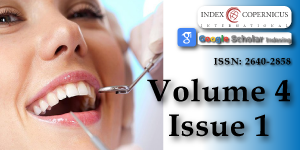An evaluation of hardness of commercially available provisional restorative materials: An in vitro study
Main Article Content
Abstract
Statement of problem: Provisional restorations play a critical role in the success of restorative treatment so they must maintain their integrity in the oral environment throughout the diagnostic and restorative phases.
Purpose: The aim of this study was to compare and evaluate the hardness of four different materials used fabrication of interim restoration.
Material and methods: Ten samples with dimensions of 10mmx10mmx2mm were fabricated from four interim materials (DPI, Tempron, Protemp 4 and Transcan). Hardness of samples was measured using Fischer scope hardness tester.
Result: The highest mean hardness was found in Heat polymerizing acrylic resin group. ANOVA test indicated F value to be 2201.01 which was highly significant (p < 0.001).
Conclusion: Heat polymerizing resin and bisacrylics may be considered in a long term provisional fixed prosthesis.
Article Details
Copyright (c) 2020 Mehraj N, et al.

This work is licensed under a Creative Commons Attribution 4.0 International License.
Rosenstiel S, Fujimoto J, Land MF. Contemporary fixed prosthodontics. 4rd ed. St. Louis: Missouri. 2007; 466.
Diaz-Arnold AM, Dunne JT, Jones AH. Microhardness of provisional fixed prosthodontic materials. J Prosthet Dent. 1999; 82: 525-528. PubMed: https://www.ncbi.nlm.nih.gov/pubmed/10559723
Savabi O, Nejatidanesh F, Fathi MH, Navabi AA, Savabi G. Evaluation of hardness and wear resistance of interim restorative materials. Dent Res J. 2013; 10: 184-189. PubMed: https://www.ncbi.nlm.nih.gov/pubmed/23946734
Jo LJ, Shenoy KK, Shetty S. Flexural strength and hardness of resins for interim fixed partial dentures. Indian J Dent Res. 2011; 22: 71-76. PubMed: https://www.ncbi.nlm.nih.gov/pubmed/21525681
Digholkar S, Madhav V, Palaskar J. Evaluation of the flexural strength and microhardness of provisional crown and bridge materials fabricated by different methods. J Indian Prosthodont Soc. 2016; 16: 328-334. PubMed: https://www.ncbi.nlm.nih.gov/pubmed/27746595
Khanna G, Aparna IN. Comparison of microhardness of three different types of acrylic artificial denture teeth: An in vitro study. J Orofac Res. 2013; 3: 181-185.
Anusavice KJ. editor. Phillip’s science of dental materials. 11th ed. St Louis: Missouri. 2003; 96-98.
Craig RG. Restorative dental materials. 8th ed. St Louis: Mosby. 1989; 103.
Pereddy MR, Janani S, Gupta B. Comparative evaluation of hardness of four provisional restorative materials: An in vitro study. Eur J Prosthodont. 2016; 4: 51-55.
Akova T, Ozkomur A, Uysal H. Effect of food-simulating liquids on the mechanical properties of provisional restorative materials. Dent Mater. 2006; 22: 1130-1134. PubMed: https://www.ncbi.nlm.nih.gov/pubmed/16386787
Yap AUJ, Mah MKS, Lye CPW, Loh PL. Influence of dietary simulating solvents on the hardness of provisional restorative materials. Dent Mater. 2004; 20: 370-376. PubMed: https://www.ncbi.nlm.nih.gov/pubmed/15019452
Pasha KSA, Bhatia S, Pandav G. An in- vitro study to compare and evaluate the hardness of various commercially available provisional restorative materials. IP Ann Prosthodon Restor Dent. 2018; 4: 44-46.
Dixon DL, Fincher M, Breeding LC, Mueninghoff LA. Mechanical properties of light-polymerizing provisional restorative material with and without reinforcement fibers. J Prosthet Dent. 1995; 73: 510-514. PubMed: https://www.ncbi.nlm.nih.gov/pubmed/11791260

